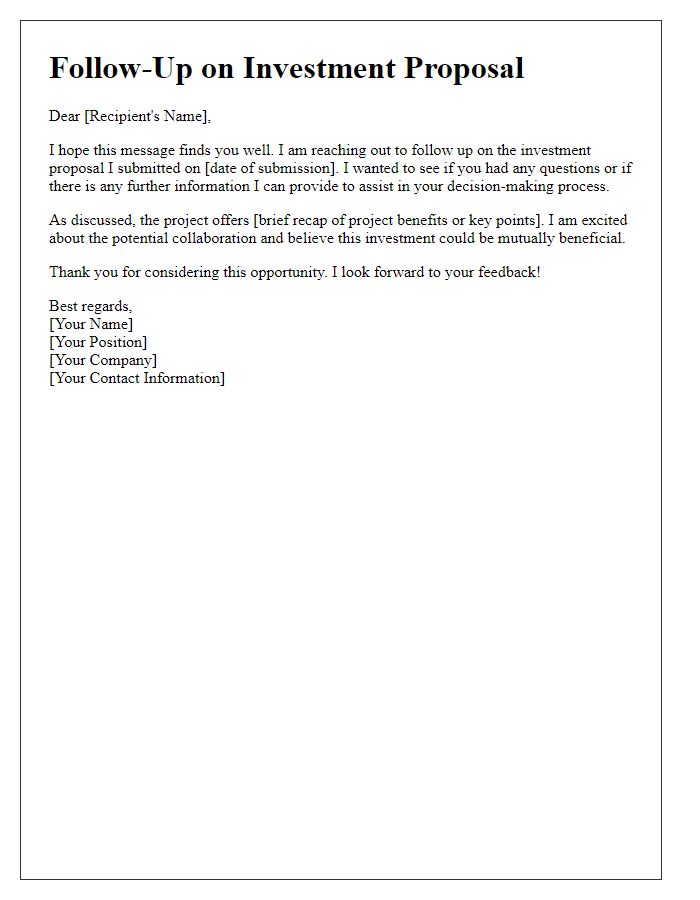Have you ever sent out a proposal and wondered what happens next? Following up can feel daunting, but it's an essential part of keeping the conversation going. In this article, we'll explore effective tips and strategies for crafting the perfect follow-up letter that not only reminds your recipient of your proposal but also strengthens your professional relationship. So, if you're ready to make a lasting impression, read on for some valuable insights!

Clear subject line
A follow-up email regarding the proposal titled "Innovative Marketing Solutions for 2024" can enhance communication effectiveness. The email should reflect a concise subject line such as "Follow-Up: Proposal for Innovative Marketing Solutions." This approach ensures immediate recognition of the content. Relevant details should include the proposal submission date (e.g., October 15, 2023), key features highlighted (such as a five-year growth strategy), and potential impacts (like a 30% increase in brand engagement). A courteous reminder of any expected feedback timeline can encourage a timely response, fostering ongoing collaboration with the recipient's organization.
Professional greeting
In a competitive business environment, a follow-up on a proposal often serves as a crucial step in the decision-making process. Sending a professional greeting can demonstrate respect and diligence. A well-crafted follow-up email or message can reiterate key aspects of the proposal, such as project timelines, benefits, and partnerships. It can also gently inquire about the status of the decision-making process. Personalized touches, such as referencing previous conversations or specific details regarding the proposal, can enhance engagement and reinforce the importance of the proposal. A clear call to action, inviting the recipient for a discussion or meeting, can also facilitate further communication.
Summary of proposal
A well-structured proposal summary effectively encapsulates the essence of a project. Effective communication is essential for proposals in business settings, such as corporate environments or project funding requests. A strong proposal should clearly list objectives, methods, target audience, and expected outcomes while highlighting the benefits. For instance, a proposal aimed at implementing a new software system for a company should outline how this system enhances efficiency, reduces costs (potentially saving over 20% annually), and improves employee productivity. Additionally, including relevant market research data (such as user adoption rates of similar software) substantiates the need for the proposal, demonstrating alignment with industry trends and organizational goals.
Benefits and value proposition
In an increasingly competitive market, providing clear benefits and value propositions becomes essential for businesses looking to engage potential clients. A compelling value proposition outlines specific advantages, such as cost savings, increased efficiency, or superior quality, that distinguish your offering from competitors. For instance, a software solution that streamlines project management can reduce operational costs by up to 20%, making it highly attractive to companies like TechCorp based in Silicon Valley. Highlighting tangible outcomes, such as improved revenue growth of 15% within the first quarter of implementation, can resonate deeply with decision-makers. Additionally, effective communication of these benefits should address the unique pain points of the target audience, ensuring your proposal remains relevant and persuasive. Providing case studies or testimonials from similar industries can further bolster credibility and encourage action.
Call to action and contact information
A compelling follow-up on a submitted proposal can greatly influence the success of a project pitch. The proposal, which outlined innovative strategies designed to increase operational efficiency by at least 25% within six months, is currently under review. The organization, a non-profit focused on environmental sustainability, seeks to secure funding for implementation. It is crucial to prompt a response, emphasizing the mutually beneficial aspects of collaboration. Prospective partners should feel encouraged to reach out for any questions or further discussion. Contact details, including a phone number and a professional email address, should be clearly stated to facilitate seamless communication and expedient decision-making.













Comments